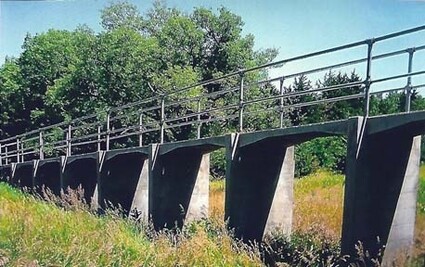A site for the seat in Nuckolls County
July 13, 2023
One of the more interesting places to be listed on the National Register of Historic Places is the Nelson Cemetery "Walk" at Nelson. Although there are several places on the register in Nuckolls County, the bridge over a sort of gully on the edge of the county seat's cemetery is certainly unique. (Courtesy photo)
(Editor's Note: The following is reprinted from the Lincoln Journal- Star edition of July 9, 2023 written by Jim McKee.)
It is unusual, but not unique, for a Nebraska county seat not to be its largest city. Nuckolls County is one example where the county seat is about one fourth the size of its largest city. Once, having 18 post offices, it now has two cities, five villages and two unincorporated communities.
Although Nuckolls County had virtually no population, the Nebraska Territorial Legislature created the county in 1858, "named for a wealthy firm of merchants doing business in Nebraska City," brothers and pro-slavery advocates Stephen F. Nuckolls and Lafayette Nuckolls, who was a member of the first territorial legislature.
It was felt that, though there were no settlements, the county was bound to succeed, partially because it was on one of the early Mormon trails which followed the Little Blue River, Russell, Majors & Waddell's Overland Stage route and hosted 16 miles of the Oregon Trail.
One of the first settlers in the county, B. S. Comstock, arrived in 1858 then brought his family, in 1861 to Oak Grove Farm on the Little Blue and there, in June of 1871, the first election was held with a total of 33 votes cast.
An election recorded variously in 1872, 1873 and 1874 put the county seat at centrally located Nelson, named for Horatio Nelson Wheeler, a landowner originally from Peoria, Illinois, in an election contest with Elkton and Vernon, both of which disappeared. 1872 is more probably correct as while "all county business was transacted at the home of D. W. Montgomery," the first, two-story, frame courthouse was completed on the northwest corner of Third and Main streets in 1873 at a cost of $2,500.
As there was no safe in the building, which also served four church denominations and a school, the first treasurer carried the county's funds on his person. Although prohibitionist's feared incorporation would invite saloons, the City of Nelson was incorporated as a village in 1873 and two years later the first county fair was held using the courthouse for its exhibits.
In 1887, the three-story, $55,000 Nelson Opera House was completed. The building, which housed the Columbia Theatre and business college, was also rented by the county for two years while a new courthouse was being built. A new brick jail, which was said was "a palace compared with the courthouse," was finished in 1882 on Court House Square, the highest elevation in the city, then, with the completion of the new courthouse in 1890, Nelson reported having more than a dozen businesses, two newspapers, three hotels, five churches and two banks.
At the age of 21, William Loudon came from Illinois on an investigating trip to Nebraska in 1870, primarily looking at Lincoln and Omaha, but the following year he filed in Beatrice for abandoned homesteads in southern Nuckolls County at a site he called Superior for the land's quality.
The city of Superior was platted with 56 square blocks in 1875. The same year saw completion of a combination grocery store and post office. Superior was incorporated as a village in 1879 and the following year the Republican Valley Division of the Burlington & Missouri River Railroad built through along First Street with a depot on Central and elevator on Commercial Street.
By 1885, three additions joined the original map, with East Superior virtually the same size as the original. Within another five years, Superior claimed there were five railroads serving the city. As Superior began to grow with railroad connections, the population grew quickly, which prompted their challenging Nelson for the county seat in 1889. Nelson, however, narrowly retained the capital.

One of the more interesting places to be listed on the National Register of Historic Places is the Nelson Cemetery "Walk" at Nelson. Although there are several places on the register in Nuckolls County, the bridge over a sort of gully on the edge of the county seat's cemetery is certainly unique. (Courtesy photo)
Termed the first settlement in what would become Nuckolls County, Oak Grove on the Little Blue was the site of the election which established the county. With a peak population of 237 in 1910, now known simply as Oak, it is estimated at 54.
Ruskin, first known as Henrietta, was established in 1887 with the arrival of the Rock Island Railroad. Its peak population of 360 in 1920 is 105 today.
Nora's post office opened in 1878, and by 1888 was served by two railroads. Its population peaked at 127 in 1920 through today its count is around 21.
Hardy, a project of the Burlington Railroad's Lincoln Land Co., was platted in 1880, reaching its peak of 496 in 1920 and today, a mere half mile from the Kansas border reports only 97. Lawrence opened its post office in 1887, peaking at 530 in 1930 but now reporting 272 inhabitants.
Nuckolls County, number 42 on state license plates, has a total population today estimated at 4,000 with about half of that in Superior and around 500 in Nelson.














Reader Comments(0)